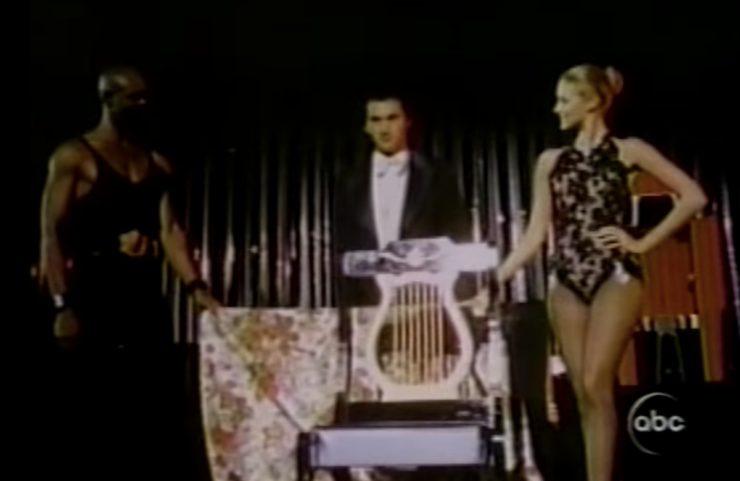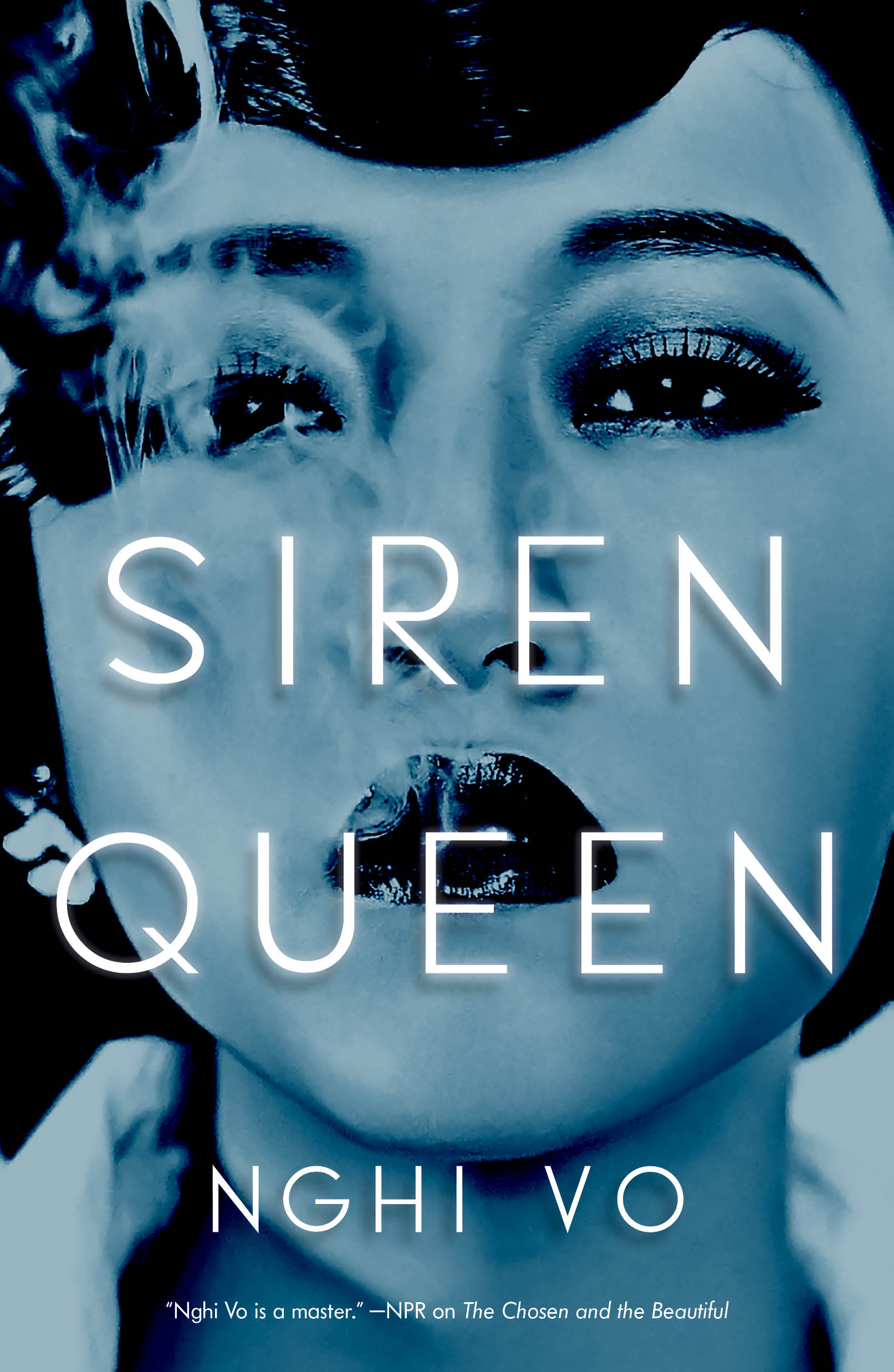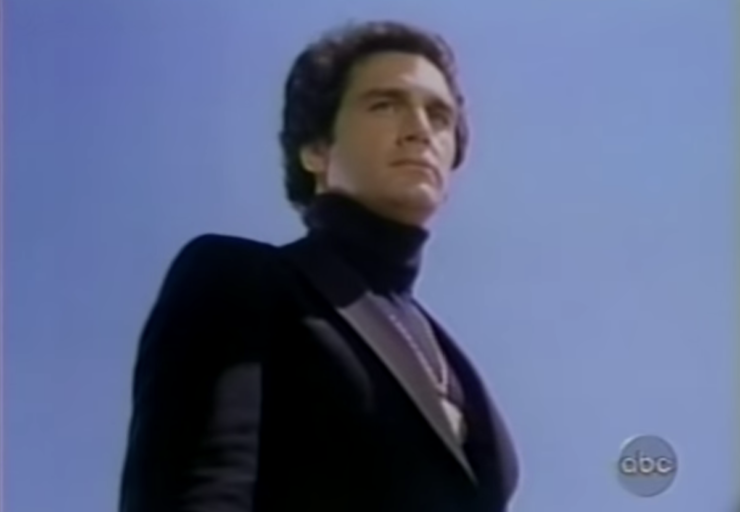From August 2017 – January 2020, Keith R.A. DeCandido took a weekly look at every live-action movie based on a superhero comic that had been made to date in the Superhero Movie Rewatch. We returned last week with a 1970s gem, It’s a Bird… It’s a Plane… It’s Superman! and we continue with another film from the swingin’ seventies this week, Mandrake. Next week we’ll look at the two Timecop movies before getting into the newer stuff.
Mandrake the Magician is considered by some to be the first comics superhero, debuting as a comic strip in 1934, four years prior to Superman. Created by Lee Falk, who would go on to also create the Phantom, Mandrake was hugely popular for many decades. A stage magician who also had powers of super-hypnosis—and other magic powers over the years—he also secretly fought crime on behalf of both the police and the international crimefighting organization Inter-Intel.
In 1979, a Mandrake TV movie was made.
At the height of their popularity, both Mandrake the Magician and The Phantom were read by 100 million readers. Mandrake’s look—top hat, black suit, pencil-thin mustache—became the stereotypical iconic image for stage magicians.
His supporting cast includes Lothar, an African prince who is the strongest man alive; Narda, a princess of the mythical land of Cockaigne, who is both Mandrake’s assistant and love interest; Hojo, the head of Inter-Intel and a skilled martial artist, who poses as Mandrake’s chef; and Mandrake’s father Theron, an immortal sorcerer.
As was typical for comics icons of the era, Mandrake starred in both a movie serial (1939, starring Warren Hull) and a radio show (1940-1942, starring Raymond Edward Johnson). A pilot for a TV show was filmed in 1954, but never went to series, and several live-action movies have been in development over the decades. Federico Fellini—a friend of Falk’s—spoke of doing a Mandrake movie in the 1960s, Embassy Pictures had the rights to do a picture in the 1980s, and Baldwin Entertainment and Hyde Park Pictures have had a Mandrake movie in development for the last fifteen years, with Jonathan Rhys Meyers, Hayden Christensen, and Sacha Baron Cohen all said to be playing Mandrake at different points. Mandrake also was part of the animated Defenders of the Earth series in 1986, appearing alongside fellow King Features Syndicate characters the Phantom and Flash Gordon.
The 1979 TV movie cast soap opera star Anthony Herrera in the title role. Herrera did not wear a top hat, wore an outfit that was more beatnik chic than Mandrake’s usual suit, and he didn’t have a mustache. (Robert Reed, as the tycoon targeted by the film’s antagonist, makes up for this with a huge-ass mustache that deserves its own billing.)
Written and produced by Rick Husky, who also created the William Shatner cop show T.J. Hooker, Mandrake toned down some of the stereotypical “exotic” aspects of Mandrake’s supporting cast. Lothar, who in the comic strip wore a fez and a leopard skin and spoke broken English until 1965, was played by Ji-Tu Cumbuka, who mostly wears suits in the movie. He also doesn’t have the comic strip version’s super-strength. Narda is replaced by Stacy, who is pretty much just Mandrake’s stage assistant, though she and Lothar both aid him in his crime-fighting. Mandrake’s father dies in a plane crash in the movie’s opening scene, and Hojo is dispensed with, instead having Alec Gordon play Hank Brandt, the head of “the agency” for whom Mandrake sometimes works.
Also appearing in the film are James Hong, who plays the Asian monk who teaches magic to Mandrake after the plane crash that claims his father; David Hooks as Dr. Malcolm Lindsay, a scientist who is twice believed to be killed; Gretchen Corbett as Jennifer, Lindsay’s daughter, and a sorta-kinda love interest for Mandrake; Peter Haskell as William Romero; and the aforementioned Robert Reed and his spectacular mustache as Arkadian, an industrialist who owns everything from amusement parks to nuclear power plants, whom Romero is targeting. Harry Blackstone Jr., who served as the magical consultant for the movie, played one of Lindsay’s scientists, Dr. Nolan.
“There is something more and something greater”
Mandrake
Written and produced by Rick Husky
Directed by Harry Falk
Original release date: January 24, 1979

In 1948, little Mandrake and his father are flying over the Himalayas when the plane crashes. His father is killed, while little Mandrake is taken in by some monks.
Jump to the present. Mandrake is now a stage magician. While he performs his act, aided by Lothar and Stacy, a scientist named Dr. Malcolm Lindsay is in the audience. Two suspicious-looking people also sit in the audience, and one sticks Lindsay with a hidden needle. Lindsay appears to have a heart attack. Mandrake tries to revive him, but his last word is, “Arkadian.” When Lothar tries to chase down the people who attacked him, they almost run him over.
Lindsay is declared dead by a doctor in the house and is taken away, but he never makes it to the morgue, and the doctor who declared him dead also disappears. In addition, Lindsay’s daughter Jennifer has been trying to get in touch with Mandrake. Her father was declared dead once before in a car crash, yet he showed up in Los Angeles.
Mandrake, Lothar, and Alec Gordon (Mandrake’s handler with the agency) pick up Jennifer and then are almost run down by the two guys from the audience of the magic show. Mandrake uses his illusion powers to make them think they’re about to run into a wall and other fun stuff. One of them gets away, but the other is taken prisoner by Gordon. However, he doesn’t reveal anything.
Their next stop is to talk to Arkadian, who is currently in San Francisco rehearsing a beauty pageant. While they’re there, one of Arkadian’s employees gets a phone call from William Romero, who speaks a post-hypnotic key phrase that compels the employee to go under the stage and plant a bomb.
No one is killed—except for the guy who was hypnotized to set the bomb—and Romero then calls Arkadian to tell him that he could’ve done it during the pageant. He’ll also plant another bomb before making his demands.
Another employee of Arkadian’s in Honolulu has his flirting with a bartender interrupted by a phone call. He hears the same key phrase and leaves the bar without a word, setting a bomb on a ship of Arkadian’s that was going to be used to raise a Russian sub that had sunk.
Buy the Book


Siren Queen
Mandrake, Lothar, and Jennifer travel to Honolulu to investigate that bombing. Mandrake uses his hypnotic mind-reading powers to project the bartender’s memories onto the wall, so they get a clear picture of what happened.
Romero demands ten million dollars from Arkadian. Mandrake visits one of Arkadian’s amusement parks, where Arkadian confesses to Mandrake that he doesn’t have any liquid cash assets—he could barely raise a million in forty-eight hours, much less the ten being demanded.
Mandrake also sees someone crawling around a roller coaster. Suspicious that this might be another hypnotized bomber, Mandrake climbs up to confront the guy, and manages to subdue him with illusions and fisticuffs.
Lothar reports that all the hypnotized bombers served in the same Navy unit. Stacy goes to keep an eye on Jennifer, only to arrive just as she’s being kidnapped.
Mandrake lets the would-be roller coaster bomber go and follows him, only to be ambushed. He’s taken prisoner, his amulet taken away. (The amulet is what enables him to do his fancy-shmancy mind-reading tricks.) Romero reveals himself to Mandrake. He was involved in a project that involved experimenting on some sailors with ESP and post-hypnotic suggestions and stuff.
While Mandrake doesn’t have his amulet, he does apparently have mad picklocking skillz, and he escapes the room he’s being held in and finds Lindsay, who explains that both the crash where he was first declared dead and the attack at the magic show were illusions to make people think he was dead. Romero wants Lindsay to computerize his mind-control formula, and is using his daughter as leverage.
Mandrake is recaptured and put in a straitjacket. He’s brought to where Jennifer is being experimented on. Mandrake gets out of the straitjacket (seriously, that’s like the first trick any decent stage magician learns, what’s wrong with these idiots?) and holds a gun on the bad guys, forcing them to free Jennifer and give him his amulet back.
However, there’s one more bomb going off, at a nuclear power plant, also owned by Arkadian. Leaving Romero and his gang to be taken in by agents, Mandrake and the Lindsays go to the power plant to stop the bomb exploding, which Mandrake is able to do with the help of his illusion powers.
The Lindsays are formally reunited and live happily ever after. They go see Mandrake do his stage act at a club that Arkadian announces that he just bought. Turns out that line about not having any liquid cash assets was a total lie…
“If I told you how I did it, then it wouldn’t be magic”

Mandrake the Magician is not only arguably the first superhero, he’s probably also one of the most influential comic book characters, just because a plurality of the clichés about stage magicians (both performative and visual) are derived in part from Lee Falk’s creation. And a big part of the appeal of the strip is the over-the-top nature of Mandrake: his two assistants are royalty who gave up their crowns to fight crime with him; one is super-powerful and the other a strong fighter. Yes, they both also embrace some pretty yucky stereotypes, especially Lothar, though that was improved by the time this movie was made. And Mandrake also lived in a giant mansion, Xanadu, located on a mountaintop in upstate New York, where a guy who runs an intelligence agency also moonlights as his chef.
It’s completely ridiculous, and pretty danged offensive, but it’s fun, at least, and embraces the crazy with a complete lack of self-consciousness.
This TV movie manages to drain almost all the life out of the concept, to ill effect. Lothar is still African royalty, but he’s no longer super-strong, and doesn’t actually do a helluva lot in the story—his one moment to show off his strength is just him almost getting run over by a car and failing to stop the bad guys. Similarly, Stacy’s one “action moment” is to get hit in the head while Jennifer is kidnapped. Otherwise, the pair only serve administrative functions.
The worst, though, is the treatment of the title character.
For starters, while everything around Mandrake is made less bombastic (and less interesting), they lean into the absurdities of Mandrake’s powers. Instead of inheriting the ability to wield magic from his immortal father, Mandrake instead learns it from Asian monks who take him in after his father dies—basically giving him the Shadow’s origin, wrapping it all up in the worst Orientalist clichés.
On top of that, they eschew Mandrake’s iconic look for suitjackets over turtlenecks and a big round medallion on his chest, making it look like Mandrake wandered over from the set of Saturday Night Fever.
Mandrake’s medallion is said to be a critical part of his magic. Without it, according to one of the flashbacks with James Hong’s monk, he can’t do his nifty tricks like create illusions of walls and fire and tarantulas and stuff, nor can he project people’s thoughts as visible images. The medallion is taken away from him for the climactic confrontation with the bad guy, but that just means that Mandrake can engage in more fisticuffs. And also escape from a straitjacket, which is something he’d have learned, not from wizened monks with a trick medallion, but when training to do stage magic.
However, the biggest issue with this movie is the disastrous casting of Anthony Herrera, who has absolutely no charisma whatsoever. Mandrake is supposed to be a performer, but all his magic act serves to do is put the viewer to sleep. He has no stage presence, no spark, no verve, no nothing. His “romance” with Jennifer is laughably absurd.
The worst is when he’s paired with Robert Reed, who is the only person in the movie who actually puts in the effort to, y’know, act. His Arkadian simply oozes capitalistic slime. Worse, he’s the victim here, so there’s an opportunity to do some fun morality-play stuff—none of which the script bothers with, of course. Still, Reed (and his mustache) elevate the movie considerably, but that barely gets it above the dirt, as it were.
Next week we take a look at something I totally missed out on the first time through this rewatch: the two Timecop movies, based on the Dark Horse comics story.
Keith R.A. DeCandido has three short stories out soon: “A Lovely View,” a tale of Zorro, in Zorro’s Exploits, edited by Audrey Parente, from Bold Venture Press; “What You Can Become Tomorrow,” a story that puts together author Mary Shelley, baseball player Josh Gibson, and NASA scientist Florence Johnson, in Three Time Travelers Walk Into…, edited by Michael A. Ventrella, from Fantastic Books; and “Smells Like Teen Spirit,” a Super City Cops story, in Tales of Capes and Cowls, edited by C.T. Phipps, from Crossroad Press.










